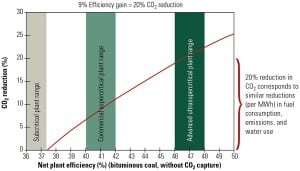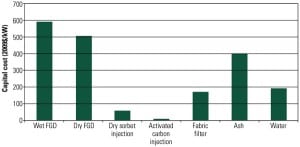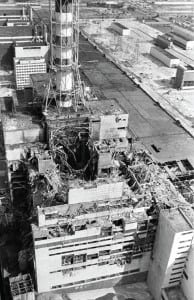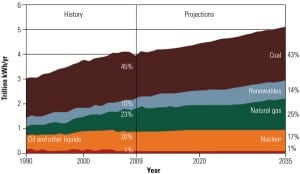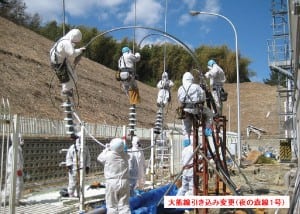POWER
-
O&M
Preventing Copper Deposition in Steam Turbines
Many large utility-scale units with copper alloy condensers and feedwater heaters lose generating capacity when copper and copper oxide deposits develop on high-pressure (HP) steam turbine blading. It is not unusual for a 400-MW unit to lose 10% of its generating capacity over a six-month period when water treatment processes aren’t properly tuned to prevent copper transport in the steam and condensate systems. In fact, one utility reported that it lost 20 MW of capacity in one month because of such deposits. The financial implications of such deposits, particularly in power markets where plants are pushed to their generating limits, are tremendous.
-
O&M
Predictive Maintenance That Works
This series of articles focuses on the nuts and bolts of predictive maintenance (PdM), also known as condition-based maintenance. A well-defined and well-executed PdM program saves time and money by reducing unneeded time-based maintenance tasks and by identifying and fixing problems before they cause equipment failure or plant shutdown. In this article, we begin introducing condition-monitoring techniques commonly in use at power plants.
-
Legal & Regulatory
Is FERC Backstop Siting Authority Still Alive?
The U.S. Court of Appeals for the Ninth Circuit recently dealt another setback to the use of Section 216 of the Federal Power Act, which gives the Federal Energy Regulatory Commission (FERC) “backstop” authority to site electric transmission lines. Although enacted in 2005, this authority has never been used by FERC, and it can be questioned whether it ever will be used.
-
Coal
Research and Development for Future Coal Generation
If coal is to be a viable long-term fuel for a significant percentage of electricity generation, research and development is needed to increase thermal efficiency, demonstrate cost-effective and secure carbon dioxide capture and storage, further improve emission controls, and reduce water demands.
-
Coal
Added Regulatory Hurdles Will Accelerate Coal Plant Retirements
The U.S. Environmental Protection Agency is developing a number of new regulations for the power sector governing air emissions, cooling water intake structures, and coal combustion waste disposal methods. Combined, these regulations have the potential to drive as much as 40% of existing coal-fired generating units to retire in the next 10 years, representing about 51 GW.
-
Coal
Predicting U.S. Coal Plant Retirements
The question concerning coal plant retirements forced by looming regulatory rules, low gas prices, and moribund load growth has changed from “Why?” to “How many plants?” Many highly detailed analyses and reports have been written on the subject by superbly qualified analysts. This approach to estimating potential plant closures is much more qualitative, and much easier to understand. However, the results closely align: About 50 GW are threatened.
-
Nuclear
Chernobyl: Twenty-Five Years of Wormwood
Twenty-five years ago last month, engineers and technicians were running low-power tests at the 1,000-MW Reactor No. 4 of the Chernobyl Nuclear Power Plant outside Kiev. They quickly, inexplicably, lost control of the light-water-cooled, graphite-moderated reactor. In an instant, the critical chain reaction flared out of control. The plant exploded like a small, dirty bomb, the graphite caught fire, and the worst catastrophe in civilian nuclear power was under way.
-
News
Nuclear Sneak Attack
A renewed attack on nuclear power immediately followed the March 11 catastrophe at the six-unit Fukushima Daiichi nuclear power complex in Japan. At least one legislator and a multitude of anti-nuclear groups have demanded that the U.S. cease approval of all new nuclear plants for the foreseeable future and/or close our Mark I boiling water reactor (BWR) plants. This knee-jerk response adds nothing substantive to the nuclear safety debate. (Be sure to read our cover story for more on this issue.)
-
Coal
Coal-Fired Generation Cost and Performance Trends
Increasing regulatory requirements and a focus on reducing carbon emissions in the U.S. have significantly reduced the number of new coal-fired plants under development compared with past years. In addition, projected capital costs for new coal-fired plants have risen sharply in the past year, while those for natural gas combined-cycle and combustion turbines have stayed relatively flat. In order to keep coal a viable energy source, many countries, including the U.S., are seeking ways to improve plant efficiency while reducing carbon emissions.
-
Nuclear
The Battle to Stabilize Daiichi
Weeks after a massive magnitude 9.0 earthquake and subsequent 14-meter-high tsunami devastated Fukushima Prefecture in northeastern Japan, workers from the Tokyo Electric Power Co. (TEPCO) were still struggling to regain control of four severely damaged reactors at the six-unit Fukushima Daiichi nuclear power plant.

